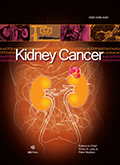Authors: Distante, Alfredo | Bertolo, Riccardo | Campi, Riccardo | Erdem, Selcuk | Calio, Anna | Palumbo, Carlotta | Pavan, Nicola | Ciccarese, Chiara | Carbonara, Umberto | Marchioni, Michele | Roussel, Eduard | Wu, Zhenjie | Mulders, Peter F.A. | Muselaers, Constantijn H.J.
Article Type:
Systematic Review
Abstract:
BACKGROUND: The role of active surveillance (AS) has been recognized as a management strategy for localized small renal masses (SRMs). The EAU guidelines suggest AS can be offered to frail and/or comorbid patients diagnosed with SRM due to the low cancer-specific-mortality (CSM) and higher competing-cause mortality. As specific cut-offs defining the characteristics of frail and comorbid patients who may benefit from AS remain less clear, our objective is to conduct a systematic review aiming to identify potential characteristics that could assist physicians in shared decision-making. METHODS: The systematic literature review was conducted following the Preferred Reporting Items for
…Systematic Reviews and Meta-Analyses statement. Two authors independently screened the literature according to the PICOs criteria previously outlined in our registered review protocol (via Pubmed, Embase, and the Cochrane Central Register of Controlled Trials), extracted data, and assessed the risk of bias, using Newcastle-Ottawa Scale. Studies that analyzed differences in patient’s tumor-related and molecular characteristics associated with any differences in growth rate (GR), overall survival (OS), cancer-specific survival (CSS), and metastasis-free survival (MFS), were considered eligible. RESULTS: Nineteen studies comprising a total of 5105 patients were analyzed. Patient-specific factors such as age and cardiovascular index, which demonstrated a predominant impact on OS, exhibited a high degree of consistency across the analyzed studies. Less concordance was found when exploring GR, with the main predictors being ethnicity, age, sex, comorbidity, symptoms, and eGFR. The analysis of tumor-related characteristics, such as tumor size, nephrometry score, and mass histology, among others, yielded contradictory outcomes concerning their impact on GR and CSS. CONCLUSION: Age, cardiovascular index, and chronic kidney disease have shown to be reliable predictors of OS. Nonetheless, significant debates persist regarding tumor characteristics or molecular markers that may influence survival and GR. Further research is awaited to shed light on the potential to identify prognostic factors. This would aid in pinpointing the subgroup of patients who could experience additional benefits from AS, potentially leading to a reduced risk of progression. It is imperative to standardize approaches to AS and reporting of results, as this will be pivotal for future quantitative analyses.
Show more
Keywords: Active surveillance, small renal masses, renal cell carcinoma, kidney
cancer
DOI: 10.3233/KCA-230025
Citation: Kidney Cancer,
vol. 8, no. 1, pp. 81-92, 2024





